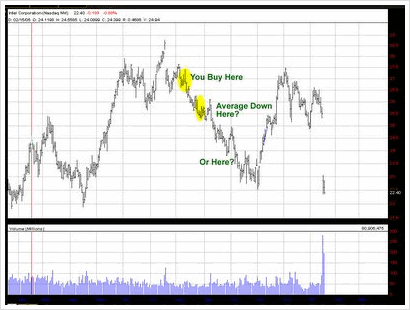Averaging down is a losing proposition
Many traders, especially those new to
the markets, have a habit of “averaging in” to trades that aren’t
going their way. The following reasoning is used: If this trade was a good entry
at my earlier price, then it must be an even better entry now! On top of that,
the trader gets caught up in the idea of improving his “average entry price.”
DaytradeTeam traders have seen this mistake all too often…
Unfortunately most traders learn the hard way that this logic
simply does not hold up. This is a natural response that everyone has, which is
exactly why it doesn’t work in a market. The reasoning that “this trade was good
then so at this price it must be even better” is based on the flawed assumption
that the first entry price was a good one.

Pride tries to keep us from realizing that the very fact that
the position is a loser right now is PROOF that the first entry was NOT a good
entry (at least not yet). In fact, the stock or option has moved in the opposite
direction the trader thought it was going to move, indicating that either the
analysis/reasoning used to take the position in the first place was incorrect or
at the very least the reasoning has been weakened by the market action since the
position was established. This does NOT mean that the trade is no longer a good
one just because you did not make your initial entry at the perfect moment (who
does?) — it just means that you probably shouldn’t be willing to put more
capital at risk now that it has started to prove you wrong.
The other part of the reasoning, that “this will improve my
average entry” is simply a mathematical illusion.
By “averaging in”, you don’t just move your entry closer to
the current price (the part Pride makes us focus on), you also double your
losing position (the part we don’t want to see). Instead of 1000 losing shares
at 10.25 you now own 2000 losing shares at 10.00 — BIG DEAL — you are still
down $500 because the stock price is still at $9.75 and now you own 1000 extra
shares of a stock that is in a downtrend instead of the uptrend you predicted!
Don’t get me wrong, it is not always a mistake to increase
your position on a losing trade — some circumstances (such as the stock sitting
right at a very strong resistance or support level) warrant it. If you
absolutely must add to a losing position, always do so with the conviction
necessary to exit the ENTIRE position quickly should the trade move against you
(through that critical support level you saw, etc.) from there.
On the flip side of the coin is the exact opposite reasoning
and the exact opposite results over time. Adding to winning positions is a
practice rarely done by even the most experienced traders, but one that can lead
to increased profitability over time. This is exactly the strategy that our #1
ranked Day Trading System has used successfully since 2000. The next few times
you hear pride telling you to “lock in your profits”, double your position and
set a stop at your new “average entry”. After 5-10 of these trades you will be
surprised at what a profitable (and a confidence building) method this can be.
Once again, traders who ignore pride and trade the opposite of
emotion will reap extra profits and a much more pleasurable trading experience.
DON’T MISUNDERSTAND ME — you will not profit more every time you add to a
winner and you won’t lose every time you add to a loser — I am talking about
trading strategies to work OVER TIME — anything can happen in the window of a
few trades.
Andy Swan
Andy Swan created and
co-founded DaytradeTeam five years ago on a principle of empowering
individual stock and options traders with the techniques and analysis methods
typically reserved for elite professionals. His expertise in technical analysis
and commitment to educating members earned DaytradeTeam a top-ranking among
advisory services for several years.
